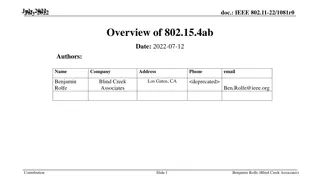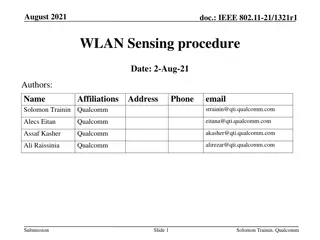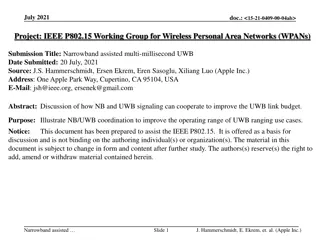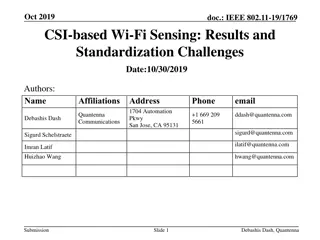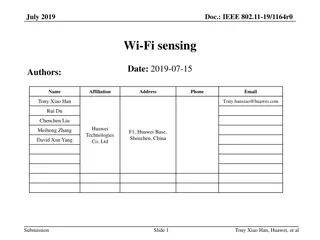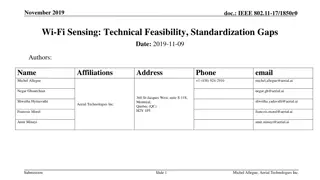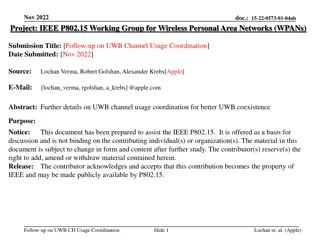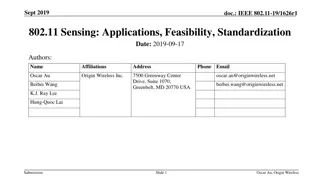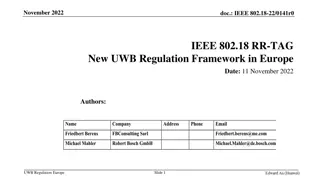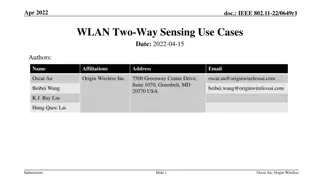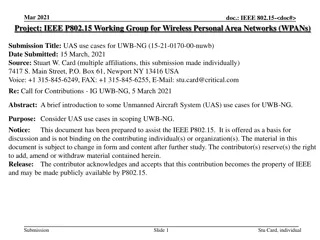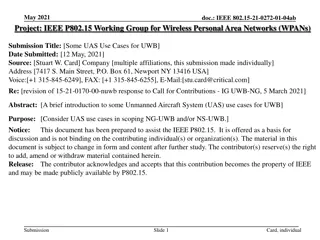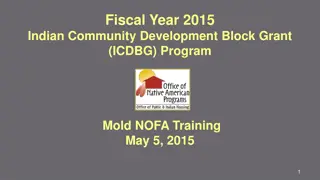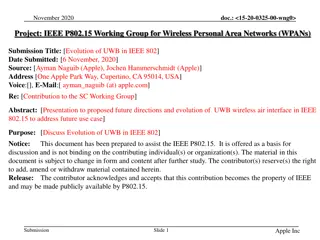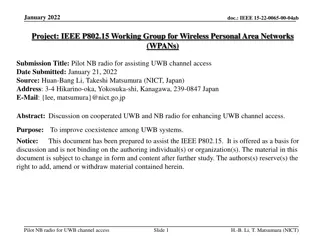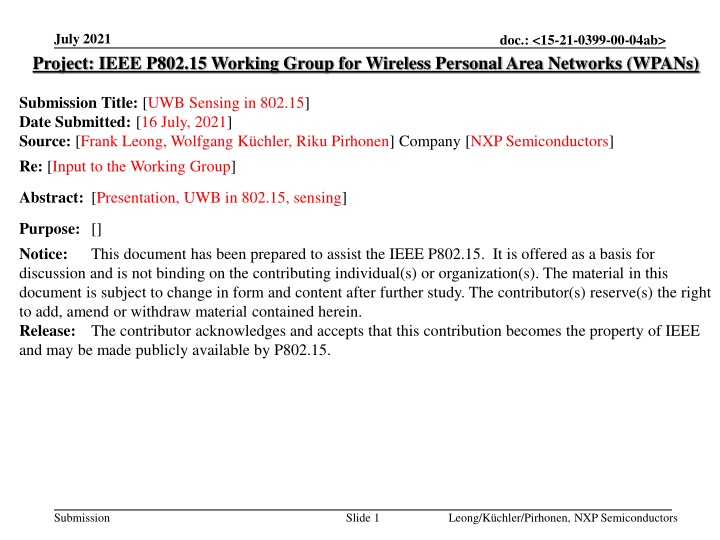
UWB Sensing in IEEE P802.15 Working Group for WPANs
"Explore the incorporation of Ultra-Wideband (UWB) sensing technology in the IEEE P802.15 Working Group for Wireless Personal Area Networks (WPANs). The submission discusses the objectives, safeguards, interference mitigation techniques, coexistence improvements, and proposed solutions related to UWB sensing in WPAN environments to enhance ranging, localization, sensing, and scheduling capabilities. Discover how UWB technology can facilitate accurate ranging, low energy consumption, and efficient channel occupancy for multiple use cases."
Download Presentation

Please find below an Image/Link to download the presentation.
The content on the website is provided AS IS for your information and personal use only. It may not be sold, licensed, or shared on other websites without obtaining consent from the author. If you encounter any issues during the download, it is possible that the publisher has removed the file from their server.
You are allowed to download the files provided on this website for personal or commercial use, subject to the condition that they are used lawfully. All files are the property of their respective owners.
The content on the website is provided AS IS for your information and personal use only. It may not be sold, licensed, or shared on other websites without obtaining consent from the author.
E N D
Presentation Transcript
July 2021 Project: IEEE P802.15 Working Group for Wireless Personal Area Networks (WPANs) doc.: <15-21-0399-00-04ab> Submission Title: [UWB Sensing in 802.15] Date Submitted: [16 July, 2021] Source: [Frank Leong, Wolfgang K chler, Riku Pirhonen] Company [NXP Semiconductors] Re: [Input to the Working Group] Abstract: [Presentation, UWB in 802.15, sensing] Purpose: [] Notice: discussion and is not binding on the contributing individual(s) or organization(s). The material in this document is subject to change in form and content after further study. The contributor(s) reserve(s) the right to add, amend or withdraw material contained herein. Release: The contributor acknowledges and accepts that this contribution becomes the property of IEEE and may be made publicly available by P802.15. This document has been prepared to assist the IEEE P802.15. It is offered as a basis for Submission Slide 1 Leong/K chler/Pirhonen, NXP Semiconductors
July 2021 doc.: <15-21-0399-00-04ab> PAR Objective Safeguards so that the high throughput data use cases will not cause significant disruption to low duty-cycle ranging use cases Interference mitigation techniques to support higher density and higher traffic use cases Other coexistence improvement Backward compatibility with enhanced ranging capable devices (ERDEVs) Improved link budget and/or reduced air-time Additional channels and operating frequencies Improvements to accuracy / precision / reliability and interoperability for high-integrity ranging Reduced complexity and power consumption Hybrid operation with narrowband signaling to assist UWB Enhanced native discovery and connection setup mechanisms Sensing capabilities to support presence detection and environment mapping Low-power low-latency streaming Higher data-rate streaming allowing at least 50 Mbit/s of throughput Support for peer-to-peer, peer-to-multi-peer, and station-to- infrastructure protocols Infrastructure synchronization mechanisms Proposed Solution (how addressed) Monostatic and multistatic radar operation Submission Slide 2 Leong/K chler/Pirhonen, NXP Semiconductors
July 2021 doc.: <15-21-0399-00-04ab> UWB Sensing in 802.15 Submission Slide 3 Leong/K chler/Pirhonen, NXP Semiconductors
July 2021 doc.: <15-21-0399-00-04ab> Sensing Context Recap Focus on key functionalities to be provided by UWB: 1.Ranging with high integrity (handsfree access use cases) 2.Localization (indoor navigation use cases) 3.Sensing (presence detection use cases) 4.Coordination & scheduling to support the above Provide accurate ranging via a low-cost, mass-market solution a. Low energy-per-ranging b. Low channel-occupancy-per-ranging a.k.a. spectral efficiency (many devices operating at the same time & place) c. Re-use of hardware between use cases Submission Slide 4 Leong/K chler/Pirhonen, NXP Semiconductors
July 2021 doc.: <15-21-0399-00-04ab> UWB Sensing Terminology (1) CIR = Channel Impulse Response (estimated characteristics) Stations/Modules Monostatic Operation (Nstations = 1) Multistatic Operation (Nstations = 2...16) Sensing Initiator/Responder One-Way/Two-Way Multistatic Sensing CIR Transmitter/Receiver Parallel/Sequential Multi-Antenna Operation Virtual Antennas (e.g., electronic beamsteering*) *) E.g., see: U. Nickel: Fundamentals of Signal Processing for Phased Array Radar , in Advanced Radar Systems, Signal and Data Processing (pp. 1-1 1-22), 2007. Submission Slide 5 Leong/K chler/Pirhonen, NXP Semiconductors
July 2021 doc.: <15-21-0399-00-04ab> UWB Sensing Terminology (2) Target Y Target X Responder Initiator Initiator Station C Station A Station B Monostatic Operation Multistatic Operation Submission Slide 6 Leong/K chler/Pirhonen, NXP Semiconductors
July 2021 doc.: <15-21-0399-00-04ab> UWB Sensing Terminology (3) Target = Sensing Packet 1 = Sensing Packet 2 Responder Initiator = Sensing Packet 3 Station B Station A One-Way vs. Two-Way Multistatic Sensing Submission Slide 7 Leong/K chler/Pirhonen, NXP Semiconductors
July 2021 doc.: <15-21-0399-00-04ab> UWB Sensing Terminology (4) = Sensing Packet Target = CIR Feedback Packet 1 Responder = CIR Feedback Packet 2 Station C (CIR Transmitter) Responder Initiator Station A (CIR Receiver) Station B (CIR Transmitter) One-Way Multistatic Sensing w/ CIR Feedback Submission Slide 8 Leong/K chler/Pirhonen, NXP Semiconductors
July 2021 doc.: <15-21-0399-00-04ab> UWB Sensing Applications Short range: up to 30 m HRP UWB is able to support this range Low velocity: up to 5 m/s (18 km/h) Vital sign detection (e.g., breathing, heart beat) Gesture recognition Approach (moving target) detection Object (stationary target) detection Direction detection (angle), trajectory mapping Maximum velocity may be traded against range High measurement resolution Resolution down to sub-cm level (using >1.5 GHz total signal bandwith) Target types (RCS -10 dBm2 a.k.a. dBsm): Adults, children, infants, pets Objects / vehicles (up to freight ship) Submission Slide 9 Leong/K chler/Pirhonen, NXP Semiconductors
July 2021 doc.: <15-21-0399-00-04ab> Rationale (1) Interference from concurrently operating radar systems is a growing problem in several RF bands* Multistatic radar performance benefits from coordinated TX and RX elements Standardize UWB sensing in order to Enable coexistence with ranging systems Enable re-use of ranging system HW Maximize the potential of multistatic radar by enabling interoperability / coordination / scheduling Avoid future interference problems Enable CIR exchange via standardized interfaces *) E.g., see: https://www.sae.org/news/2021/06/mitigating-radar-to-radar-interference Submission Slide 10 Leong/K chler/Pirhonen, NXP Semiconductors
July 2021 doc.: <15-21-0399-00-04ab> Rationale (2) Interference management is central: Coordination / Scheduling Enable sensors to interact with other stations Compact (i.e., low airtime) means of CIR exchange Global approach to UWB waveform multiplexing methods Leverage preamble codes Submission Slide 11 Leong/K chler/Pirhonen, NXP Semiconductors
July 2021 doc.: <15-21-0399-00-04ab> UWB Sensing & Ranging (1) UWB suits both sensing and ranging However, performance metrics differ between the two modes Ranging performance is strongly related to SNR (e.g., associated with the Ziv-Zakai bound*) Dynamic Range (also in the presence of unwanted signals) Sensing performance is strongly related to Bandwidth (leveraging a unique UWB property**) Quality of range-velocity data processing *) This bound is named after the same Jacob Ziv known for LZ{77,78} for data compression, recipient of the 2021 IEEE Medal of Honor; the paper in question is: J. Ziv and M. Zakai, "Some Lower Bounds on Signal Parameter Estimation", IEEE Trans. Information Theory, vol. IT-15, no. 3, pp. 386-391, May 1969. **) E.g., see: https://www.ll.mit.edu/sites/default/files/outreach/doc/2018-07/lecture%202.pdf Submission Slide 12 Leong/K chler/Pirhonen, NXP Semiconductors
July 2021 doc.: <15-21-0399-00-04ab> UWB Sensing & Ranging (2) UWB suits both sensing and ranging Both modes benefit from large signal bandwidth Both modes benefit from waveforms with high quality autocorrelation properties (i.e., clean ranging/radar ambiguity function ) Packets may be used for both ranging and sensing at the same time Sensing may justify shifting additional energy to the preamble or adding closely scheduled packets to a (legacy) ranging exchange Sensing may justify use of overall signal bandwidths beyond 500 MHz Achievable in low-cost multi-channel UWB implementations with already existing ~500 MHz pulse bandwidths Hardware re-use, but dedicated packet scheduling for sensing Define interfaces supporting multi-channel CIR exchange Submission Slide 13 Leong/K chler/Pirhonen, NXP Semiconductors
July 2021 doc.: <15-21-0399-00-04ab> UWB Sensing CIR Sharing Multistatic operation Responder has CIR (in case of two-way sensing, initiator also has CIR) Initiator may request CIR (in case of two-way sensing, responder may also request CIR) Transmission of CIR to be tightly coupled to measurement (correlation between CIR measurement success and CIR transmission success ) Tightly coupled (i.e., timing deltas 5 ms) using wired or wireless interface (e.g., 802.15.4 UWB, NB) Sensing station may refuse transmitting its CIR (e.g., in case of corrupted measurement) CIR to be transmitted in a format that does not overly stress the wireless channel (e.g., compressed/delta-only/per-target) Submission Slide 14 Leong/K chler/Pirhonen, NXP Semiconductors


